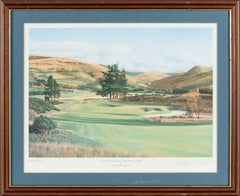Graeme Baxter
1990s Photorealist Landscape Prints
Paper, Watercolor, Color, Giclée
People Also Browsed
Late 20th Century Impressionist Landscape Paintings
Oil
A Close Look at Photorealist Art
A direct challenge to Abstract Expressionism’s subjectivity and gestural vigor, Photorealism was informed by the Pop predilection for representational imagery, popular iconography and tools, like projectors and airbrushes, borrowed from the worlds of commercial art and design.
Whether gritty or gleaming, the subject matter favored by Photorealists is instantly, if vaguely, familiar. It’s the stuff of yellowing snapshots and fugitive memories. The bland and the garish alike flicker between crystal-clear reality and dreamy illusion, inviting the viewer to contemplate a single moment rather than igniting a story.
The virtues of the “photo” in Photorealist art — infused as they are with dazzling qualities that are easily blurred in reproduction — are as elusive as they are allusive. “Much Photorealist painting has the vacuity of proportion and intent of an idiot-savant, long on look and short on personal timbre,” John Arthur wrote (rather admiringly) in the catalogue essay for Realism/Photorealism, a 1980 exhibition at the Philbrook Museum of Art, in Tulsa, Oklahoma. At its best, Photorealism is a perpetually paused tug-of-war between the sacred and the profane, the general and the specific, the record and the object.
“Robert Bechtle invented Photorealism, in 1963,” says veteran art dealer Louis Meisel. “He took a picture of himself in the mirror with the car outside and then painted it. That was the first one.”
The meaning of the term, which began for Meisel as “a superficial way of defining and promoting a group of painters,” evolved with time, and the core group of Photorealists slowly expanded to include younger artists who traded Rolleiflexes for 60-megapixel cameras, using advanced digital technology to create paintings that transcend the detail of conventional photographs.
On 1stDibs, the collection of Photorealist art includes work by Richard Estes, Ralph Goings, Chuck Close, Audrey Flack, Charles Bell and others.
Finding the Right Landscape-drawings-watercolors for You
Landscape drawings and watercolors show the world through the lenses of different cultures and perspectives. They were also incredibly important for displaying natural scenes before the invention of photography.
There are many ways to effectively arrange art on your walls so that you’re maximizing your wall space. You can introduce peace and serenity within the confines of a living room or bedroom if landscape drawings and watercolors are part of the art that you choose to bring into a space.
Watercolor landscapes have a rich history dating back to ancient China, where they dominated painting genres by the late Tang dynasty. Ink-on-silk paintings in China featured mountains and large bodies of water as far back as the third century. The Netherlands was home to landscapes as a major theme in painting as early as the 1500s, and by the Renaissance, watercolors had made their way to the West and into European culture, becoming a staple of decorative art.
It wasn’t until the Industrial Revolution that watercolor paints became more widely available and embedded in fine arts. Despite their broad distribution today, some artists have chosen to revive the old craft of preparing their own watercolor pigments, paying homage to the medium’s roots.
The variety of brush combinations and painting methods makes watercolor landscapes some of the most stunning pieces in any collection. Find landscape drawings and watercolors on 1stDibs.
